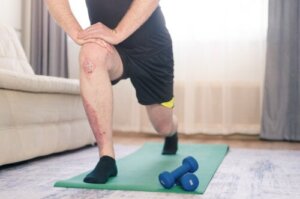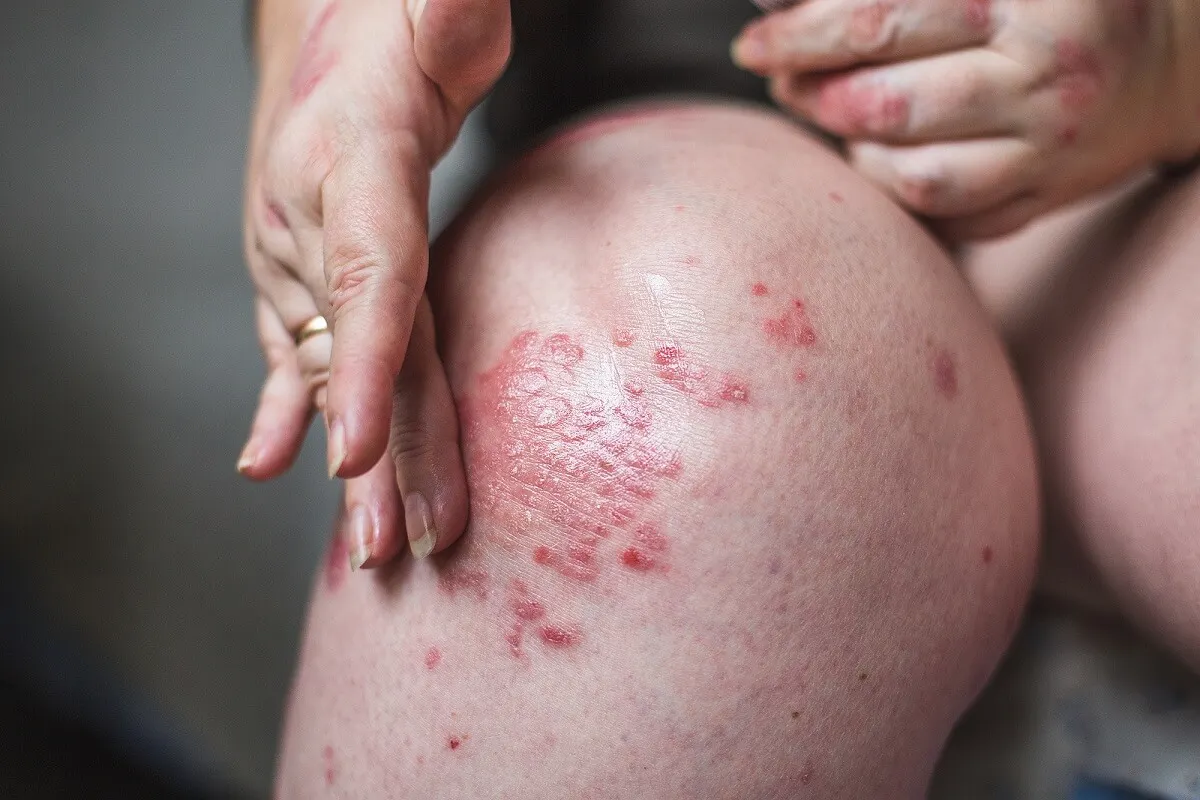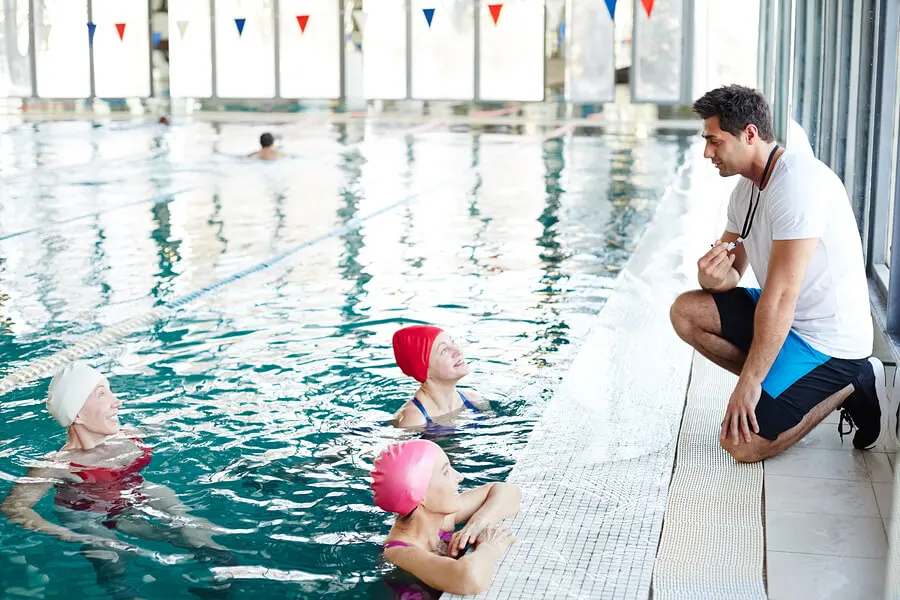The Benefits of Physical Exercise for Psoriasis

A healthy lifestyle, both in terms of diet, emotional management, and physical exercise, helps to control psoriasis flare-ups. Depending on the severity of the diagnosis and with dermatological guidance, you can practice sports that contribute positively to the treatment of the disease.
Treating psoriasis is not just about taking care of the appearance of your skin. When you address the internal factors with medication and activities that promote your overall well-being, there’s a greater chance of moderating the sequelae. In this article, we’ll show you the overall contribution of exercise to this condition.
Psoriasis: A problem in the immune system
Psoriasis is a chronic skin disease caused by alterations in the immune system. The Clínica Universidad de Navarra (CUN) explains that this disease causes delimited erythematous plaques covered by pearly scales on the skin.
Sometimes, the diagnosis of this disease even leads to dysfunctional capacity. It’s even possible that the first medical evaluation may be confused with rheumatoid arthritis.
The causes have to do with genetics, infections, stress and secondary reactions to some medications. Apart from the joint tissue, the following areas of the body are affected:
- Face
- Nails
- Elbows
- Knees
- Genitals
- Scalp
- The soles of the feet
- Mucosa of the mouth
- The palms of the hands
- The lower back
Symptoms and types of psoriasis
According to the Mayo Clinic, the symptoms of psoriasis vary from person to person. In general, the signs are marked by the appearance of a red or purple, rough-textured rash or patches.
The skin cracks, to the point of bleeding, itching and burning. These manifestations are cyclical.
In terms of classification, there are the following types:
- Inverse psoriasis: This causes red, smooth, shiny lesions in soft areas and folds, such as the armpits, buttocks and under the breasts.
- Nail psoriasis: The fingernails or toenails grow abnormally, change color, and itch. There’s a risk of onycholysis.
- Droplet psoriasis: These are small spots on the extremities or on the body. This type of psoriasis is frequently diagnosed in children.
- Pustular psoriasis: This shows as pus blisters surrounded by patches of redness. Its appearance is localized, reduced or extensive. It is most commonly diagnosed in adults.
- Psoriatic arthritis: This consists of joint inflammation linked to cutaneous alterations. It usually appears some time after the skin lesions.
- Plaques psoriasis: This is the most common form, and consists of the formation of higher lacerations in relation to the rest of the skin. It may be covered by a scaly layer.
- Erythrodermic psoriasis: This is inflammatory and affects a large part of the body. The lamellae tend to peel off, causing intense pain and discomfort. It is the least frequent of the psoriasis.

We think you may also enjoy reading this article: What Is Psoriasis and What Are the Different Kinds?
The link between physical exercise and psoriasis
Exercise is beneficial for psoriasis.
Studies suggest that regular sport reduces skin flare-ups. In fact, the NGO Acción Psoriasis recommends physical activity several times a week, for 45-minute periods.
Suggested disciplines include walking, cycling, swimming and dancing. The NGO emphasizes the selection of an exercise that the person enjoys, because this way the habit is more easily maintained.
Exercising should be carried out as much as possible. Sometimes, the pain of psoriatic arthritis makes movement difficult. This is often the case for cases of plantar psoriasis or if the person chooses a contact sport.
The keyis to choose an activity of moderate intensity that’s been approved by a specialist.
What are the benefits of physical exercise for psoriasis?
Exercise has a complementary role in the treatment of this skin disease, affecting the efficacy of medications and the patient’s quality of life. Let’s take a look at the main advantages of physical exercise for psoriasis.
It minimizes the danger of hypertension and diabetes
Psoriasis increases the level of severity of hypertension cases, compared to people without the immune condition, as stated by the Spanish Heart Foundation.
They add that hypertensive problems lead to risks of cardiovascular events. As a preventive measure, daily exercise tops the advice, along with a heart-healthy diet, not smoking, and moderating your alcohol consumption.
On the other hand, the journal Diabetes reports that patients with psoriasis show more insulin resistance. The Centers for Disease Control and Prevention (CDC) also notes that physical activity makes the body more sensitive to this hormone, thus reducing blood sugar.
It helps fight obesity
The visible symptoms of psoriasis influence some diagnosed people to change their lifestyle to hide their skin lesions. Some even avoid going out and avoid outdoor sports or gyms.
This sedentary lifestyle could lead to obesity. In fact, a publication in the journal Actas Dermo-Sifiliográficas mentions that, just as the disease intervenes in the weight disorder, obesity also predisposes a person to psoriasis.
Therefore, exercise is necessary to treat obesity. You can fuse it with a healthy diet for psoriasis, guided by a health advisor, without resorting to strict regimes that worsen the condition.
It helps increase muscle strength
Spondylotherapy distinguishes physical exercise for psoriasis as a mainstay of treatment. This scientific content network asserts that sport relieves the pain and stiffness of psoriatic arthritis and enhances muscle quality.
To achieve this, the person should perform routines that include aerobic and muscle-strengthening exercises. They should do this in addition to isometric circuits, in case of acute joint inflammation.
It improves flexibility in the joints
Acción Psoriasis comments that aquagym, swimming, and walking in water are all very good exercises for people with psoriatic arthritis. Aquatic exercises protect joints from impacts and improve flexibility, especially if performed in warm water.

It contributes to socialization and positive self-esteem
In diseases such as psoriasis, exercise is also beneficial for socializing with others. The Journal of Social Studies echoes research that shows the benefits of sport in terms of socialization and improved quality of life.
On self-esteem, the INFAD Journal of Psychology reports that physical exercise enhances self-esteem, and self-concept and improves indicators of depression and subjective well-being.
Exercise reduces stress
The Spanish Academy of Dermatology and Venereology tells us that stress is related to the worsening of psoriasis. For its part, the American Psychological Association (AAP) points out that exercise is good for mental health, as it helps the brain to cope with stress.
The AAP speaks of preliminary evidence that physically active people have lower rates of depression and anxiety as opposed to those who lead a sedentary life.
Like this article? You may also like to read: Can You Treat Psoriasis with Traditional Chinese Medicine?
Supportive therapies along with physical exercise for psoriasis
There are multiple treatment alternatives for psoriasis, notes the SA Pharmaceutical Journal. They describe everything from topical medicine for mild diagnoses to phototherapy, systemic therapy, or biologic agents, depending on the severity.
With the help of a dermatologist, people with psoriasis can decide on the type of treatment and appropriate exercises to cope with the condition. Consult your trusted physician for more information.
All cited sources were thoroughly reviewed by our team to ensure their quality, reliability, currency, and validity. The bibliography of this article was considered reliable and of academic or scientific accuracy.
- Carrascosa JM, Cool-Puigserver N, Fernández Torres RM, Fonseca E, Jiménez Puya R, Moreno JC, Rocamora V. Obesidad y psoriasis: naturaleza inflamatoria de la obesidad, relación entre psoriasis y obesidad e implicaciones terapéuticas. Actas Dermo-Sifilográficas. Vol. 105. Núm. 5. pp. 31-44. España; 2014. https://www.actasdermo.org/es-obesidad-psoriasis-naturaleza-inflamatoria-obesidad-articulo-S0001731012004577
- Conoce cómo la diabetes tiene una estrecha relación con la psoriasis. Revista Diabetes. Puerto Rico; 2021. https://revistadiabetespr.com/conoce-como-la-diabetes-tiene-una-estrecha-relacion-con-la-psoriasis/
- De la Torre Cruz T, Escolar Llamazares M, Jiménez Eguizábal A, Luis Rico I, Palmero Cámara C. Beneficios psicológicos de la práctica deportiva entre mayores vs intergeneracional. International Journal of Developmental and Educational Psychology. Revista INFAD de Psicología. Vol. 2. Núm. 2. p. 139. España; 2018. https://www.mendeley.com/catalogue/c010bf53-40ba-3465-922c-60b0b9358683/?utm_source=desktop&utm_medium=1.19.4&utm_campaign=open_catalog&userDocumentId=%7B96758513-7b87-4e2c-95be-72b4ad0449da%7D
- Ejercicio acuático para tus articulaciones. Acción Psoriasis. España. https://www.accionpsoriasis.org/sobre-la-psoriasis/vivir-con-psoriasis/785-ejercicio-acuatico-para-tus-articulaciones.html#:~:text=El%20ejercicio%20f%C3%ADsico%20moderado%20es,la%20salud%20%C3%B3sea%20y%20cardiovascular.
- Ejercicios para la artritis psoriásica. Espondilopedia. España. https://www.espondilopedia.es/artritis-psoriasica/ejercicios/
- El deporte, un aliado con beneficios físicos y emocionales. Acción Psoriasis. España. https://www.accionpsoriasis.org/sobre-la-psoriasis/vivir-con-psoriasis/503-el-deporte-un-aliado-con-beneficios-fisicos-y-emocionales.html
- Guía para pacientes con psoriasis. Academia Española de Dermatología y Venereología. España. https://aedv.es/wp-content/uploads/2020/06/Gui%CC%81a-psoriasis-VF1.pdf
- Haga actividad física. Centros para el Control y la Prevención de Enfermedades. Estados Unidos; 2020. https://www.cdc.gov/diabetes/spanish/living/beactive.html
- Jacobs T, Kgokolo C. Tratamiento de la psoriasis. Revista Farmacéutica SA. Vol. 49. Núm. 2. p. 150. Sur África; 2006. https://www.mendeley.com/catalogue/39fdeca6-d53d-38b5-9ab5-0b0c4501ff84/?utm_source=desktop&utm_medium=1.19.4&utm_campaign=open_catalog&userDocumentId=%7B4cb8c539-6a9d-4a1c-b54d-28d60db907fa%7D
- La psoriasis acentúa hasta cinco veces más la gravedad de la hipertensión. Fundación Española del Corazón. España. https://fundaciondelcorazon.com/prensa/notas-de-prensa/2658-psoriasis-acentua-hasta-cinco-veces-mas-gravedad-de-hipertension-.html
- Los atenuadores del estrés del cerebro. Asociación Americana de Psicología. Estados Unidos; 2008. https://www.apa.org/topics/exercise-fitness/ejercicio
- Psoriasis. Clínica Mayo. Estados Unidos; 2022. https://www.mayoclinic.org/es-es/diseases-conditions/psoriasis/symptoms-causes/syc-20355840#:~:text=La%20psoriasis%20es%20una%20enfermedad,cr%C3%B3nica)%20que%20no%20tiene%20cura.
- Psoriasis. Clínica Universidad de Navarra. España. https://www.cun.es/enfermedades-tratamientos/enfermedades/psoriasis
- Ramírez W, Suárez G, Vinaccia S. El impacto de la actividad física y el deporte sobre la salud, la cognición, la socialización y el rendimiento académico: una revisión teórica. Revista de Estudios Sociales. Vol. 18. pp. 67-75. Colombia; 2004. https://www.mendeley.com/catalogue/fd4a2d71-f84a-3ba1-a1d7-15be628df2bf/?utm_source=desktop&utm_medium=1.19.4&utm_campaign=open_catalog&userDocumentId=%7Bc63c4998-c869-4b7f-92e7-f19794b2560c%7D
This text is provided for informational purposes only and does not replace consultation with a professional. If in doubt, consult your specialist.








